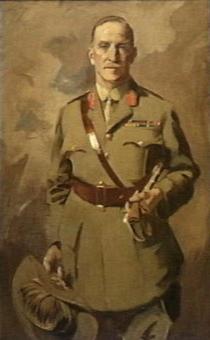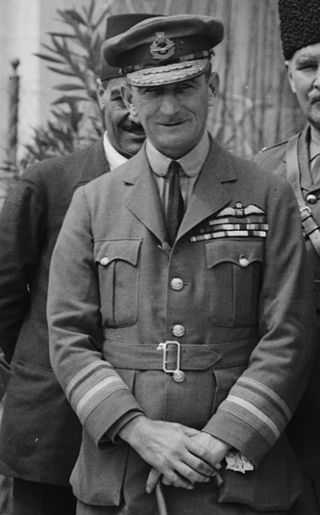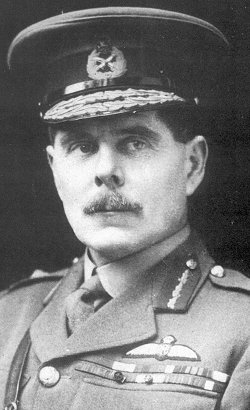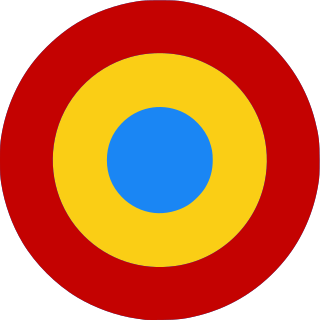
The Royal Flying Corps (RFC) was the air arm of the British Army before and during the First World War until it merged with the Royal Naval Air Service on 1 April 1918 to form the Royal Air Force. During the early part of the war, the RFC supported the British Army by artillery co-operation and photographic reconnaissance. This work gradually led RFC pilots into aerial battles with German pilots and later in the war included the strafing of enemy infantry and emplacements, the bombing of German military airfields and later the strategic bombing of German industrial and transport facilities.

General Sir Henry George Chauvel, was a senior officer of the Australian Imperial Force who fought at Gallipoli and during the Sinai and Palestine Campaign in the Middle Eastern theatre of the First World War. He was the first Australian to attain the rank of lieutenant general and later general, and the first to lead a corps. As commander of the Desert Mounted Corps, he was responsible for one of the most decisive victories and fastest pursuits in military history.

Marshal of the Royal Air Force Sir Edward Leonard Ellington, was a senior officer in the Royal Air Force. He served in the First World War as a staff officer and then as director-general of military aeronautics and subsequently as controller-general of equipment. In the inter-war years he held command positions in the Middle East, in India and then in Iraq. He served as Chief of the Air Staff in the mid-1930s and in that role he implemented a plan, known as 'Scheme F'. This scheme implemented an increase in the size of the Royal Air Force to 187 squadrons within three years to counter the threat from Hitler's Germany. He also broke up the command known as "Air Defence of Great Britain" to create RAF Fighter Command, RAF Bomber Command, RAF Coastal Command and RAF Training Command. He then served as Inspector-General of the RAF until his retirement in 1940.

The Allies, or the Entente powers, were an international military coalition of countries led by France, the United Kingdom, Russia, the United States, Italy, and Japan against the Central Powers of Germany, Austria-Hungary, the Ottoman Empire, and Bulgaria during the First World War (1914–1918).

Air Vice Marshal Sir Frederick Hugh Sykes, was a British military officer and politician.

Marshal of the Royal Air Force Sir John Maitland Salmond, was a British military officer who rose to high rank in the Royal Flying Corps and then the Royal Air Force. During the First World War he served as a squadron commander, a wing commander and then as General Officer Commanding the RAF on the Western Front towards the end of the war. He went on to be Air Officer Commanding British Forces in Iraq in the early 1920s when he halted a Turkish invasion and sought to put down a Kurdish uprising against King Faisal, the British-sponsored ruler of Iraq. He was Chief of the Air Staff in the early 1930s and bitterly opposed the position taken by British politicians at the World Disarmament Conference in Geneva, which would have led to the UK's complete aerial disarmament. In the event the talks broke down when Adolf Hitler withdrew from the Conference in October 1933.

Air Chief Marshal Sir William Geoffrey Hanson Salmond, was a senior commander in the Royal Flying Corps during the First World War. Remaining in the Royal Air Force after the war, he held senior appointments in the Middle East, Great Britain and India. In late 1928 and early 1929, he directed the evacuation from Kabul of British embassy staff and others, by air.

Brigadier General Alfred Joseph Bessell-Browne was an Australian Army colonel and temporary brigadier general in the First World War. He retired as a brigadier general in 1942.

Major General Herbert William Lloyd, was an Australian Army officer who served in the First and Second World Wars.

Air Vice Marshal Amyas Eden Borton, was a pilot and commander in the Royal Flying Corps during the First World War and a senior commander in the Royal Air Force during the 1920s. He saw active service on the Western Front, in Palestine and in Iraq. In the latter part of his career, Borton was the second Commandant of the RAF College at Cranwell before becoming the Air Officer Commanding RAF Inland Area.
No. 1 Wing of the Royal Air Force was a Wing of aircraft squadrons which was originally established as the First Wing of the Royal Flying Corps.

Hugh Trenchard was the commander of the Royal Flying Corps in France from 25 August 1915 until 2 January 1918.

The Romanian Air Corps or Aviation Corps (RAC) was the air arm of the Romanian army until the formation of the Romanian Air Force. It was established on 1 April 1913 as the Military Aeronautics Service and subordinated to the Engineer Inspectorate, being organized in two branches – the aviation and the balloon branch. On 23 August 1915, the RAC was formed as an independent military arm and operated until 1 January 1924 when it became an equal to the Army and Navy, being redesignated as the Royal Romanian Air Force.

General Officers of World War I is an oil painting by John Singer Sargent, completed in 1922. It was commissioned by South African financier Sir Abraham Bailey, 1st Baronet to commemorate the generals who commanded British and British Empire armies in the First World War.

The leaders of the Central Powers of World War I were the political or military figures who commanded or supported the Central Powers.
Brigadier-General Cuthbert Gurney Hoare was an officer of the British and Indian Army, who served in the Royal Flying Corps during World War I, and as the commander of Royal Flying Corps Canada.

Nicolae Petala was a Romanian general who was one of the generals of the Romanian Land Forces in the First World War. He served as commander of the 1st Army and several army corps and divisions in the campaigns of 1916, 1917, and 1918.















